Changhan Wang
Jack
DC-Spin: A Speaker-invariant Speech Tokenizer for Spoken Language Models
Oct 31, 2024Abstract:Spoken language models (SLMs) have gained increasing attention with advancements in text-based, decoder-only language models. SLMs process text and speech, enabling simultaneous speech understanding and generation. This paper presents Double-Codebook Speaker-invariant Clustering (DC-Spin), which aims to improve speech tokenization by bridging audio signals and SLM tokens. DC-Spin extracts speaker-invariant tokens rich in phonetic information and resilient to input variations, enhancing zero-shot SLM tasks and speech resynthesis. We propose a chunk-wise approach to enable streamable DC-Spin without retraining and degradation. Comparisons of tokenization methods (self-supervised and neural audio codecs), model scalability, and downstream task proxies show that tokens easily modeled by an n-gram LM or aligned with phonemes offer strong performance, providing insights for designing speech tokenizers for SLMs.
The Llama 3 Herd of Models
Jul 31, 2024Abstract:Modern artificial intelligence (AI) systems are powered by foundation models. This paper presents a new set of foundation models, called Llama 3. It is a herd of language models that natively support multilinguality, coding, reasoning, and tool usage. Our largest model is a dense Transformer with 405B parameters and a context window of up to 128K tokens. This paper presents an extensive empirical evaluation of Llama 3. We find that Llama 3 delivers comparable quality to leading language models such as GPT-4 on a plethora of tasks. We publicly release Llama 3, including pre-trained and post-trained versions of the 405B parameter language model and our Llama Guard 3 model for input and output safety. The paper also presents the results of experiments in which we integrate image, video, and speech capabilities into Llama 3 via a compositional approach. We observe this approach performs competitively with the state-of-the-art on image, video, and speech recognition tasks. The resulting models are not yet being broadly released as they are still under development.
XLAVS-R: Cross-Lingual Audio-Visual Speech Representation Learning for Noise-Robust Speech Perception
Mar 21, 2024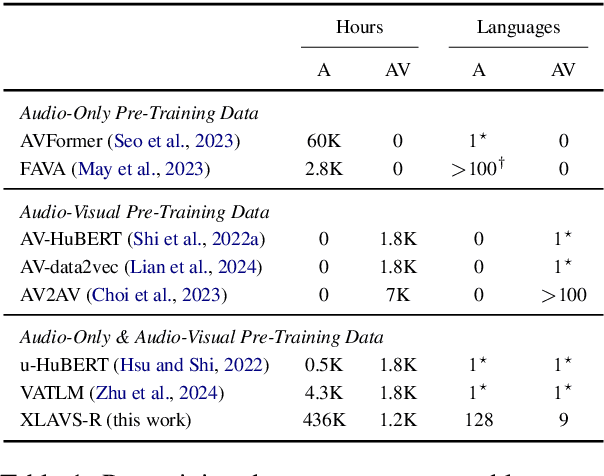
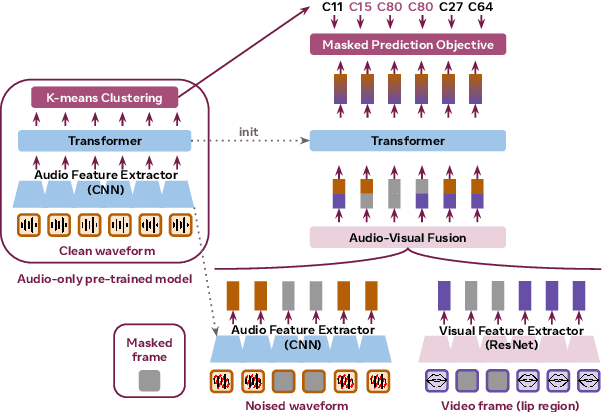
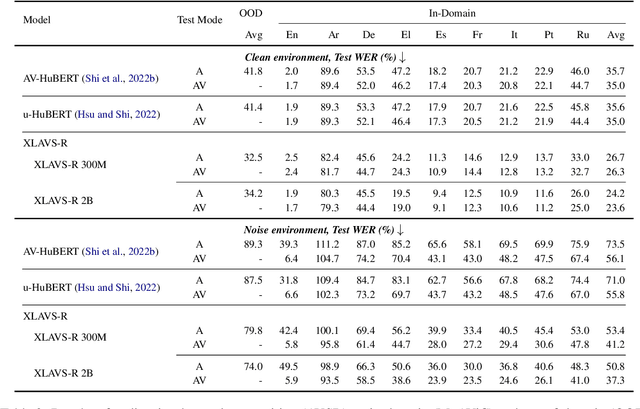
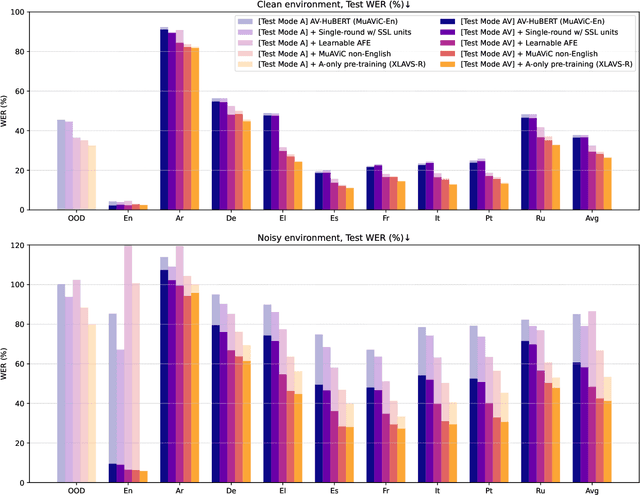
Abstract:Speech recognition and translation systems perform poorly on noisy inputs, which are frequent in realistic environments. Augmenting these systems with visual signals has the potential to improve robustness to noise. However, audio-visual (AV) data is only available in limited amounts and for fewer languages than audio-only resources. To address this gap, we present XLAVS-R, a cross-lingual audio-visual speech representation model for noise-robust speech recognition and translation in over 100 languages. It is designed to maximize the benefits of limited multilingual AV pre-training data, by building on top of audio-only multilingual pre-training and simplifying existing pre-training schemes. Extensive evaluation on the MuAViC benchmark shows the strength of XLAVS-R on downstream audio-visual speech recognition and translation tasks, where it outperforms the previous state of the art by up to 18.5% WER and 4.7 BLEU given noisy AV inputs, and enables strong zero-shot audio-visual ability with audio-only fine-tuning.
An Empirical Study of Speech Language Models for Prompt-Conditioned Speech Synthesis
Mar 19, 2024



Abstract:Speech language models (LMs) are promising for high-quality speech synthesis through in-context learning. A typical speech LM takes discrete semantic units as content and a short utterance as prompt, and synthesizes speech which preserves the content's semantics but mimics the prompt's style. However, there is no systematic understanding on how the synthesized audio is controlled by the prompt and content. In this work, we conduct an empirical study of the widely used autoregressive (AR) and non-autoregressive (NAR) speech LMs and provide insights into the prompt design and content semantic units. Our analysis reveals that heterogeneous and nonstationary prompts hurt the audio quality in contrast to the previous finding that longer prompts always lead to better synthesis. Moreover, we find that the speaker style of the synthesized audio is also affected by the content in addition to the prompt. We further show that semantic units carry rich acoustic information such as pitch, tempo, volume and speech emphasis, which might be leaked from the content to the synthesized audio.
MSLM-S2ST: A Multitask Speech Language Model for Textless Speech-to-Speech Translation with Speaker Style Preservation
Mar 19, 2024Abstract:There have been emerging research interest and advances in speech-to-speech translation (S2ST), translating utterances from one language to another. This work proposes Multitask Speech Language Model (MSLM), which is a decoder-only speech language model trained in a multitask setting. Without reliance on text training data, our model is able to support multilingual S2ST with speaker style preserved.
Seamless: Multilingual Expressive and Streaming Speech Translation
Dec 08, 2023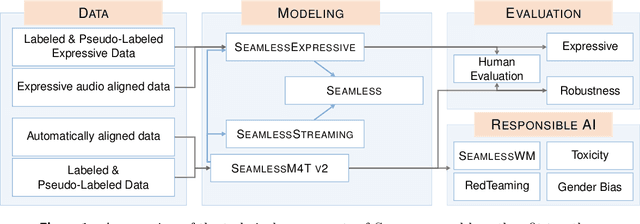
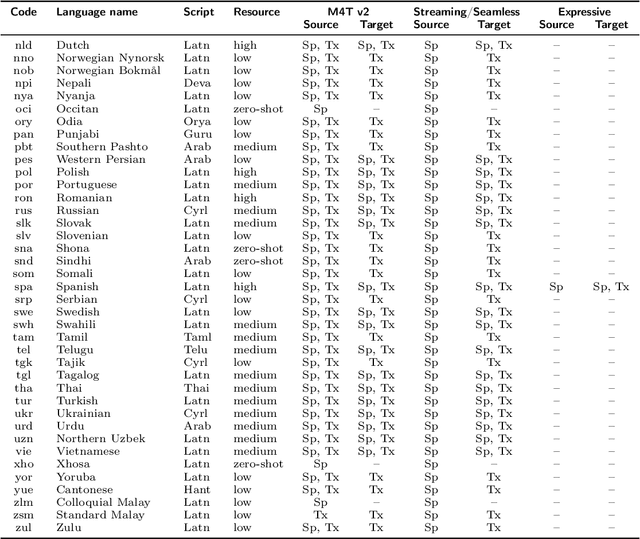

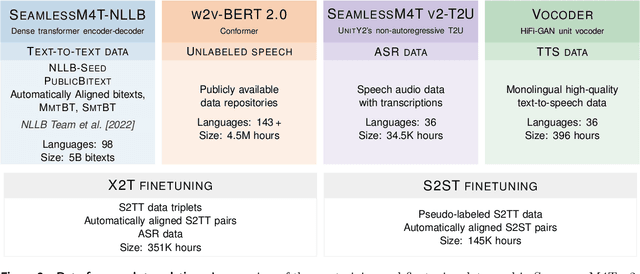
Abstract:Large-scale automatic speech translation systems today lack key features that help machine-mediated communication feel seamless when compared to human-to-human dialogue. In this work, we introduce a family of models that enable end-to-end expressive and multilingual translations in a streaming fashion. First, we contribute an improved version of the massively multilingual and multimodal SeamlessM4T model-SeamlessM4T v2. This newer model, incorporating an updated UnitY2 framework, was trained on more low-resource language data. SeamlessM4T v2 provides the foundation on which our next two models are initiated. SeamlessExpressive enables translation that preserves vocal styles and prosody. Compared to previous efforts in expressive speech research, our work addresses certain underexplored aspects of prosody, such as speech rate and pauses, while also preserving the style of one's voice. As for SeamlessStreaming, our model leverages the Efficient Monotonic Multihead Attention mechanism to generate low-latency target translations without waiting for complete source utterances. As the first of its kind, SeamlessStreaming enables simultaneous speech-to-speech/text translation for multiple source and target languages. To ensure that our models can be used safely and responsibly, we implemented the first known red-teaming effort for multimodal machine translation, a system for the detection and mitigation of added toxicity, a systematic evaluation of gender bias, and an inaudible localized watermarking mechanism designed to dampen the impact of deepfakes. Consequently, we bring major components from SeamlessExpressive and SeamlessStreaming together to form Seamless, the first publicly available system that unlocks expressive cross-lingual communication in real-time. The contributions to this work are publicly released and accessible at https://github.com/facebookresearch/seamless_communication
Exploring Speech Enhancement for Low-resource Speech Synthesis
Sep 19, 2023



Abstract:High-quality and intelligible speech is essential to text-to-speech (TTS) model training, however, obtaining high-quality data for low-resource languages is challenging and expensive. Applying speech enhancement on Automatic Speech Recognition (ASR) corpus mitigates the issue by augmenting the training data, while how the nonlinear speech distortion brought by speech enhancement models affects TTS training still needs to be investigated. In this paper, we train a TF-GridNet speech enhancement model and apply it to low-resource datasets that were collected for the ASR task, then train a discrete unit based TTS model on the enhanced speech. We use Arabic datasets as an example and show that the proposed pipeline significantly improves the low-resource TTS system compared with other baseline methods in terms of ASR WER metric. We also run empirical analysis on the correlation between speech enhancement and TTS performances.
SeamlessM4T-Massively Multilingual & Multimodal Machine Translation
Aug 23, 2023
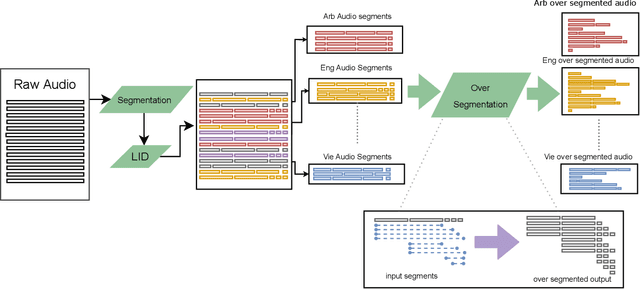
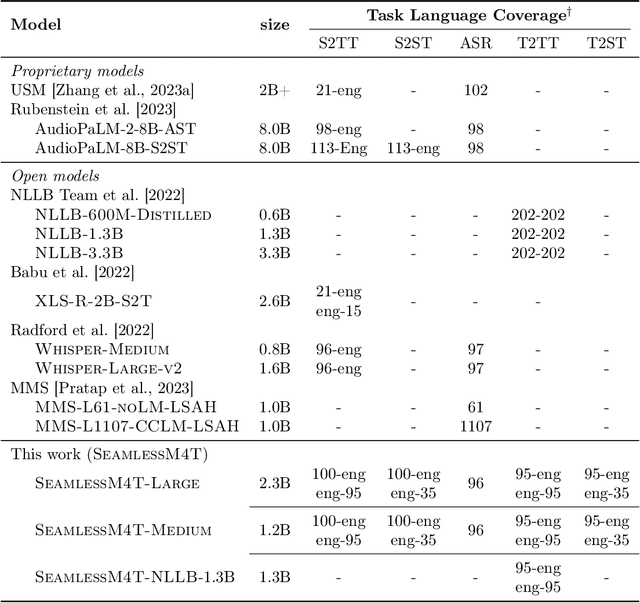
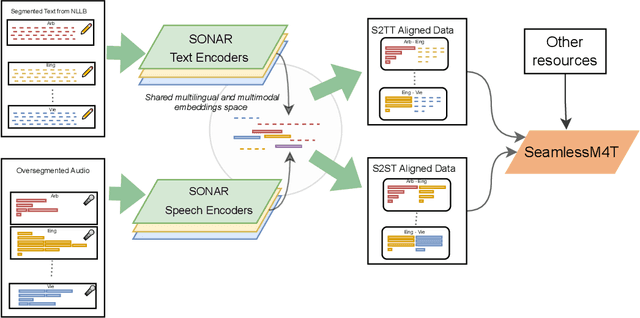
Abstract:What does it take to create the Babel Fish, a tool that can help individuals translate speech between any two languages? While recent breakthroughs in text-based models have pushed machine translation coverage beyond 200 languages, unified speech-to-speech translation models have yet to achieve similar strides. More specifically, conventional speech-to-speech translation systems rely on cascaded systems that perform translation progressively, putting high-performing unified systems out of reach. To address these gaps, we introduce SeamlessM4T, a single model that supports speech-to-speech translation, speech-to-text translation, text-to-speech translation, text-to-text translation, and automatic speech recognition for up to 100 languages. To build this, we used 1 million hours of open speech audio data to learn self-supervised speech representations with w2v-BERT 2.0. Subsequently, we created a multimodal corpus of automatically aligned speech translations. Filtered and combined with human-labeled and pseudo-labeled data, we developed the first multilingual system capable of translating from and into English for both speech and text. On FLEURS, SeamlessM4T sets a new standard for translations into multiple target languages, achieving an improvement of 20% BLEU over the previous SOTA in direct speech-to-text translation. Compared to strong cascaded models, SeamlessM4T improves the quality of into-English translation by 1.3 BLEU points in speech-to-text and by 2.6 ASR-BLEU points in speech-to-speech. Tested for robustness, our system performs better against background noises and speaker variations in speech-to-text tasks compared to the current SOTA model. Critically, we evaluated SeamlessM4T on gender bias and added toxicity to assess translation safety. Finally, all contributions in this work are open-sourced and accessible at https://github.com/facebookresearch/seamless_communication
Enhancing Speech-to-Speech Translation with Multiple TTS Targets
Apr 10, 2023



Abstract:It has been known that direct speech-to-speech translation (S2ST) models usually suffer from the data scarcity issue because of the limited existing parallel materials for both source and target speech. Therefore to train a direct S2ST system, previous works usually utilize text-to-speech (TTS) systems to generate samples in the target language by augmenting the data from speech-to-text translation (S2TT). However, there is a limited investigation into how the synthesized target speech would affect the S2ST models. In this work, we analyze the effect of changing synthesized target speech for direct S2ST models. We find that simply combining the target speech from different TTS systems can potentially improve the S2ST performances. Following that, we also propose a multi-task framework that jointly optimizes the S2ST system with multiple targets from different TTS systems. Extensive experiments demonstrate that our proposed framework achieves consistent improvements (2.8 BLEU) over the baselines on the Fisher Spanish-English dataset.
MuAViC: A Multilingual Audio-Visual Corpus for Robust Speech Recognition and Robust Speech-to-Text Translation
Mar 07, 2023Abstract:We introduce MuAViC, a multilingual audio-visual corpus for robust speech recognition and robust speech-to-text translation providing 1200 hours of audio-visual speech in 9 languages. It is fully transcribed and covers 6 English-to-X translation as well as 6 X-to-English translation directions. To the best of our knowledge, this is the first open benchmark for audio-visual speech-to-text translation and the largest open benchmark for multilingual audio-visual speech recognition. Our baseline results show that MuAViC is effective for building noise-robust speech recognition and translation models. We make the corpus available at https://github.com/facebookresearch/muavic.
 Add to Chrome
Add to Chrome Add to Firefox
Add to Firefox Add to Edge
Add to Edge